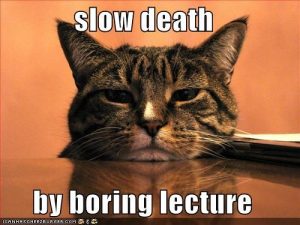 Does the term lecturing creatively sound like an oxymoron? For many of us, the thought of a traditional lecture generally brings to mind images of sleeping students, however that does not need to be the case. Read on to find out what Brookfield (2015) suggests in Chapter 6 of his book The Skillful Teacher.
Does the term lecturing creatively sound like an oxymoron? For many of us, the thought of a traditional lecture generally brings to mind images of sleeping students, however that does not need to be the case. Read on to find out what Brookfield (2015) suggests in Chapter 6 of his book The Skillful Teacher.
First, although discussion is often throught to be the polar opposite of lecture, these two strategies are not mutally exclusive methods, with discussion being “good” and lecture being “bad”. The key, regardless of the method is providing clarity on a topic.
Five reasons for choosing lectures:
- To establish the broad outline of a body of material
- To explain, with frequent examples, concepts that learners struggle to understand
- To introduce alternative perspectives and interpretation
- To model intellectual attitudes and behaviours yo wish to encourage in students
- To encourage learners’ interest in a topic (Brookfield, 2015, p. 71-72)
Some ways to utilize lecture effectively include:
1. Use a mix of approaches
- Deliberately introduc periods of silence every 10-15 minutes.

- Introduce buzz groups (small groups with purposeful discussion) into lectures
- Lecture from “Siberia”, the furthest point in the classroom away (eg. side or back)
- Spatial separation – lecturing from different areas in classroom which each represent differing perspectives on topic
- Break lecture into chunks of about 12 minutes and speak to separate ideas for each period.
- Use clickers or other classroom response systems
- Use social media (e.g. live twitter feed with questions)
2. Organize lectures
- Provide scaffolding notes
- Give clear verbal signals
3. Model learning behaviours
- Begin every lecture with a question
- End each lecture with a series of questions that have either been raised or left unanswered
- Deliberately introduce alternative perspectives
- Introduce periods of assumption hunting
 Thoughtfully considering what approach is best for a specific topic is key and then implementing some of these strategies will help students get the most out of this approach.
Thoughtfully considering what approach is best for a specific topic is key and then implementing some of these strategies will help students get the most out of this approach.
From: Brookfield, S. (2015). The skillful teacher: On technique, trust, and responsiveness in the classroom. San Francisco: Jossey-Bass.